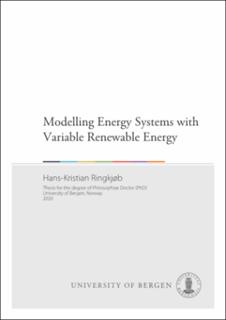| dc.contributor.author | Ringkjøb, Hans-Kristian | |
| dc.date.accessioned | 2020-05-07T13:30:38Z | |
| dc.date.available | 2020-05-07T13:30:38Z | |
| dc.date.issued | 2020-05-15 | |
| dc.date.submitted | 2020-05-01T07:37:03.436Z | |
| dc.identifier | container/54/fa/0c/3b/54fa0c3b-6742-4bbb-bbdb-29f4a545da9d | |
| dc.identifier.uri | https://hdl.handle.net/1956/22129 | |
| dc.description.abstract | Today, the majority of anthropogenic greenhouse gas emissions stem from the burning of fossil fuels for energy purposes. In order to avoid devastating consequences of climate change, the world needs to reduce its emissions and transition its energy system to one based on low carbon technologies. This transition has already begun. Renewable energy technologies, in particular solar and wind power, have seen massive growth in recent years, largely driven by political ambitions, cost reductions and technological improvement. However, since solar and wind are variable energy sources which depend on the weather for their electricity generation, challenges arise when they constitute a large part of the energy system. Using long-term energy system modelling tools, this thesis focuses on gaining a better understanding of how to transition to a low carbon future, and how variable renewable energy technologies could be integrated into the energy system. Such tools are widely used to support policy, but many of them use a low temporal resolution that could be insufficient to represent solar and wind variability. One of the main objectives of this thesis is therefore to assess how such models treat solar and wind, explore how e.g. stochastic modelling techniques can improve their representation, and by extension contribute towards more robust decision making. Two cases are modelled. First, pathways for how a remote isolated settlement in the Arctic can transition from a coal-based energy system to one based on renewable energy technologies are investigated. The results show that a stochastic modelling approach is needed to ensure a reliable energy supply, which could be based on solar and wind, energy storage, import of hydrogen and adequate back-up capacity. Second, a model of the European power and district heat sectors is used to explore the impact of modelling methodology and temporal resolution on model accuracy and performance. Here, the findings show that a stochastic modelling approach is preferred over deterministic models, even when the temporal resolution of the deterministic models is significantly increased. This case study also shows that a low carbon European power system is the preferred pathway going forward, with solar and wind, energy storage and cross-country interconnections as critical contributors. This thesis demonstrates how energy modelling tools can be used to aid in the challenge of transitioning to a low carbon energy system with large shares of variable renewables, and presents techniques that leads to more robust results and a more accurate knowledge base for decision makers. | en_US |
| dc.language.iso | eng | eng |
| dc.publisher | The University of Bergen | en_US |
| dc.relation.haspart | Paper 1: A review of modelling tools for energy and electricity systems with large shares of variable renewables. Ringkjøb HK, Haugan PM, Solbrekke IM. Renewable and Sustainable Energy Reviews 96, 2018: 440-459. The article is available in the main thesis. The article is also available at: <a href="https://doi.org/10.1016/j.rser.2018.08.002" target="blank">https://doi.org/10.1016/j.rser.2018.08.002</a> | en_US |
| dc.relation.haspart | Paper 2: Transitioning remote Arctic settlements to renewable energy systems - a modelling study of Longyearbyen, Svalbard. Ringkjøb HK, Haugan PM, Nybø A. Applied Energy 258, 2020: 114079. The article is available in the main thesis. The article is also available at: <a href="https://doi.org/10.1016/j.apenergy.2019.114079" target="blank"> https://doi.org/10.1016/j.apenergy.2019.114079</a> | en_US |
| dc.relation.haspart | Paper 3: Short-term solar and wind variability in long-term energy system models - a European case study. Ringkjøb HK, Haugan PM, Seljom PM, Lind A, Wagner F, Mesfun S. Energy 209, 2020:118377. The article is available in the main thesis. The article is also available at: <a href="https://doi.org/10.1016/j.energy.2020.118377" target="blank">https://doi.org/10.1016/j.energy.2020.118377</a> | en_US |
| dc.rights | Attribution-NonCommercial-NoDerivs (CC BY-NC-ND) | eng |
| dc.rights.uri | https://creativecommons.org/licenses/by-nc-nd/4.0/ | eng |
| dc.title | Modelling Energy Systems with Variable Renewable Energy | en_US |
| dc.type | Doctoral thesis | |
| dc.date.updated | 2020-05-01T07:37:03.436Z | |
| dc.rights.holder | Copyright the Author. | en_US |
| dc.contributor.orcid | https://orcid.org/0000-0002-0539-5959 | |
| fs.unitcode | 12-44-0 | |

